Quick Look
Grade Level: 3 (3-4)
Time Required: 2 hours 30 minutes
(separated into three 50-minute classes, not necessarily 3 days in a row)
Expendable Cost/Group: US $0.00
Group Size: 2
Activity Dependency: None
Subject Areas: Measurement, Science and Technology
NGSS Performance Expectations:

| 3-5-ETS1-1 |
| 3-5-ETS1-2 |
| 3-5-ETS1-3 |
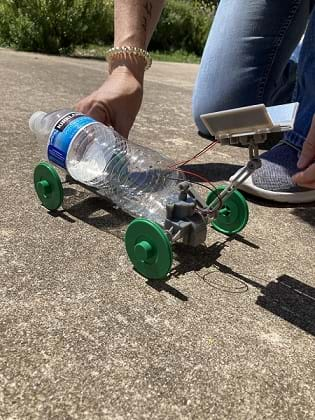
Summary
Students learn that solar energy is a renewable energy source from the sun that can be collected and used to power different items, and that solar panels allow us to gather this energy in one place and use it as electricity. As a renewable resource, the sun provides a clean and abundant source of energy that can help reduce pollution and harm to the environment. To model this process, students use a solar powered rover kit to make a car out of recycled materials. In groups of two, students use the Engineering Design Process (EDP) and follow each of the steps to complete, test, redesign, and retest their cars. Students test their car in the sun with the panel at two different angles and then once in the shade. What worked best? Then the race is on!Engineering Connection
The process of designing and building solar-powered rovers from recycled materials not only introduces students to the concept of renewable energy but also provides a practical application of engineering principles. Through this hands-on activity, students engage in the Engineering Design Process (EDP), a structured approach used by engineers to solve real-world problems.
Learning Objectives
After this activity, students are expected to:
- Work through the Engineering Design Process.
- Investigate energy in everyday life.
- Explore solutions to real-world problems.
Educational Standards
Each TeachEngineering lesson or activity is correlated to one or more K-12 science,
technology, engineering or math (STEM) educational standards.
All 100,000+ K-12 STEM standards covered in TeachEngineering are collected, maintained and packaged by the Achievement Standards Network (ASN),
a project of D2L (www.achievementstandards.org).
In the ASN, standards are hierarchically structured: first by source; e.g., by state; within source by type; e.g., science or mathematics;
within type by subtype, then by grade, etc.
Each TeachEngineering lesson or activity is correlated to one or more K-12 science, technology, engineering or math (STEM) educational standards.
All 100,000+ K-12 STEM standards covered in TeachEngineering are collected, maintained and packaged by the Achievement Standards Network (ASN), a project of D2L (www.achievementstandards.org).
In the ASN, standards are hierarchically structured: first by source; e.g., by state; within source by type; e.g., science or mathematics; within type by subtype, then by grade, etc.
NGSS: Next Generation Science Standards - Science
| NGSS Performance Expectation | ||
|---|---|---|
|
3-5-ETS1-1. Define a simple design problem reflecting a need or a want that includes specified criteria for success and constraints on materials, time, or cost. (Grades 3 - 5) Do you agree with this alignment? |
||
| Click to view other curriculum aligned to this Performance Expectation | ||
| This activity focuses on the following Three Dimensional Learning aspects of NGSS: | ||
| Science & Engineering Practices | Disciplinary Core Ideas | Crosscutting Concepts |
| Define a simple design problem that can be solved through the development of an object, tool, process, or system and includes several criteria for success and constraints on materials, time, or cost. Alignment agreement: | Possible solutions to a problem are limited by available materials and resources (constraints). The success of a designed solution is determined by considering the desired features of a solution (criteria). Different proposals for solutions can be compared on the basis of how well each one meets the specified criteria for success or how well each takes the constraints into account. Alignment agreement: | People's needs and wants change over time, as do their demands for new and improved technologies. Alignment agreement: |
| NGSS Performance Expectation | ||
|---|---|---|
|
3-5-ETS1-2. Generate and compare multiple possible solutions to a problem based on how well each is likely to meet the criteria and constraints of the problem. (Grades 3 - 5) Do you agree with this alignment? |
||
| Click to view other curriculum aligned to this Performance Expectation | ||
| This activity focuses on the following Three Dimensional Learning aspects of NGSS: | ||
| Science & Engineering Practices | Disciplinary Core Ideas | Crosscutting Concepts |
| Generate and compare multiple solutions to a problem based on how well they meet the criteria and constraints of the design problem. Alignment agreement: | Research on a problem should be carried out before beginning to design a solution. Testing a solution involves investigating how well it performs under a range of likely conditions. Alignment agreement: At whatever stage, communicating with peers about proposed solutions is an important part of the design process, and shared ideas can lead to improved designs.Alignment agreement: | Engineers improve existing technologies or develop new ones to increase their benefits, to decrease known risks, and to meet societal demands. Alignment agreement: |
| NGSS Performance Expectation | ||
|---|---|---|
|
3-5-ETS1-3. Plan and carry out fair tests in which variables are controlled and failure points are considered to identify aspects of a model or prototype that can be improved. (Grades 3 - 5) Do you agree with this alignment? |
||
| Click to view other curriculum aligned to this Performance Expectation | ||
| This activity focuses on the following Three Dimensional Learning aspects of NGSS: | ||
| Science & Engineering Practices | Disciplinary Core Ideas | Crosscutting Concepts |
| Plan and conduct an investigation collaboratively to produce data to serve as the basis for evidence, using fair tests in which variables are controlled and the number of trials considered. Alignment agreement: | Tests are often designed to identify failure points or difficulties, which suggest the elements of the design that need to be improved. Alignment agreement: Different solutions need to be tested in order to determine which of them best solves the problem, given the criteria and the constraints.Alignment agreement: | |
State Standards
Texas - Science
-
explore different forms of energy, including mechanical, light, sound, and heat/thermal in everyday life;
(Grade
3)
More Details
Do you agree with this alignment?
Materials List
Each student group needs:
- Solar Rover Kit-1 kit per each student pair or 1 kit for classroom demonstration of activity
- aluminum cans, small milk cartons, small milk cartons typically available in school cafeterias, plastic water bottles, or any variety of recyclable materials to use as the base of the solar car
- Data Collection Worksheet for each student group
- Exit Ticket for each student group
- science notebooks for each student group (can be made by students)
Class Needs:
- copy of Rosie Revere, Engineer, by Andera Beaty, or the video
- large chart tablet for brainstorming
- recycled materials
- scissors
- tape
- screwdriver (5)
- construction paper & items to decorate car
- glue
Worksheets and Attachments
Visit [www.teachengineering.org/activities/view/uot-2803-solar-powered-car-design-activity] to print or download.Pre-Req Knowledge
Students should have a basic understanding of the concept that energy comes from the sun.
Students should understand that light from the sun is light energy.
Students should have an understanding of the cost associated with using gasoline and environmental impacts compared to solar/electric powered cars.
Introduction/Motivation
I’ve got a few questions to get us started today: Have you traveled anywhere in a car or bus recently? What have you heard adults say about putting gas in the car? If you know about or have an electric car, what problems have you heard adults discuss about that source of power?
The boy in the story I’m going to read you had a big imagination and used it to plan and design a fantasy car. I’d like you to use your imagination while we’re reading the story to think about a more realistic power source for a car. (Read aloud Rosie Revere, Engineer, by Andrea Beaty, to help students think imaginatively and as problem solvers. After reading the book, ask students to turn and talk with a partner about powering a car if they built one.)
Mechanical engineers plan, design, and build cars while keeping many factors in mind, such as power source, weight of the vehicle, and shape of the vehicle to use as little energy (from any source) as possible. They also have to keep in mind the cost of these sources of energy for the car owners. Engineers ask themselves what the problems are and then imagine solutions to those problems. They also research current power sources and the problems they create before working together to design, create, and test a possible solution.
Next, we’re going to watch a couple of videos about solar energy and light energy.
(Watch What is Solar Energy? (5:07 minutes) and What is Light Energy? (3:40 minutes).
Then talk through renewable and nonrenewable resources, and create a chart with the positive and negative aspects of each. What makes a good power source?)
Procedure
Before the Activity
- Find a sidewalk or similar surface outside that has both shady and sunny areas. Note that this activity is weather-dependent, requiring sunshine for students to test their cars.
- Gather materials; arrange the recyclable materials on a table in a central area in the room so that students can see them.
- Optional: A week before the activity, ask students to search for and bring in a variety of recyclable materials such as aluminum cans, small milk cartons, small milk cartons typically available in school cafeterias, plastic water bottles, etc.
- Divide the class into groups (suggested to be groups of 2, but the activity could be done with groups of 3-4 or the whole class).
- If using the Rover kit from Amazon, put together the frames for each group; the screws are too small for 3rd graders to do this during the activity.
- Ensure that each student has a science notebook (distribute before class, if needed).
- Print out explanations of each step from the video of the Engineering Design Process to post around the room for students to reference during the lesson.
- Set up a “finish line” outside for students to race their cars to during the activity. This can be a line of chalk on the sidewalk or something similar.
During the Activity
Ask/Imagine/Research
- Introduce students to the activity using the resources in the Introduction/Motivation section.
- Use this video to introduce the Engineering Design Process and talk about each team using the EDP to plan, create, and test a model car using recycled materials.
- Have each team turn and talk to brainstorm ideas for renewable energy sources for a car. Ask students what powers their family car or cars they’ve seen. Have students ponder the following questions: Is this a good source of energy? Why or why not?
- Have students imagine different renewable energy sources. As needed, encourage them to draw from what they learned in the videos about solar and light energy.
- Share and record answers on a large sheet of paper or on the whiteboard in front of the entire class.
Plan
- Ask student groups to sketch a plan for a car powered by renewable energy. Point out the “recycling table” (i.e., the table with recycled materials on it they can use to build the base of their car).
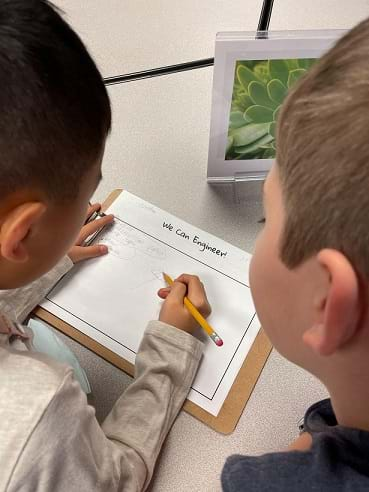
Students working through the engineering design process: How should we build it? What materials should we use? - Walk around to check on their progress and ask groups the following questions:
- What factors should be considered?
- Is the weight of the car important? Why or why not?
- What recycled materials will you use?
- Have each group share their ideas with the class.
- Allow student groups to make adjustments to their plan after listening to each group talk.
- As students adjust their plan, walk around and ask groups: Is there a factor that your group didn’t consider? Why might this be important?
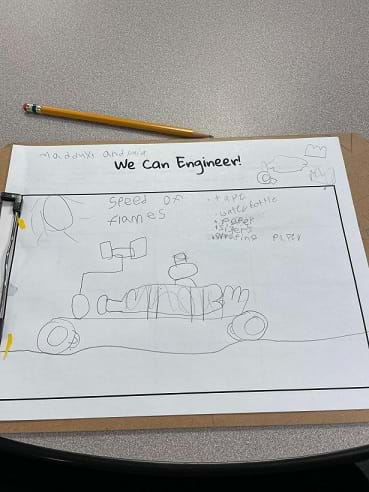
Create
- Assign the following roles for better use of time, if necessary. Roles might include the following:
- Supply Collector
- Time Keeper
- Recorder
- Task Manager
- Set a time limit of 15 minutes to keep students focused on their plan. Keep the timer on countdown at the front of the room.
- Have students collect supplies from the recycling table and a Solar Rover Kit to create their car and follow their plan to begin building their car.
Test
- Distribute the Data Collection Worksheet to groups.
- Have student teams carry the car outside to the sidewalk to test it in the shade and in the sun, once with the panel facing the sun and the other with the panel facing away from the sun. Have them record their findings on the Data Collection Worksheet.
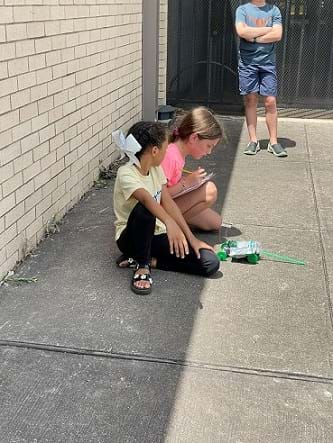
Testing and observing results: What is the car doing? - After the shade and sun test, students will race their cars using start and finish lines created by the teacher. Students observe and record which cars made it to the finish line first. Ask students: What was different about the cars that finished first?
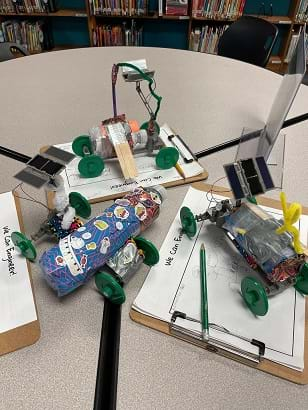
Examples of other projects. So fun to see all the creative work and different ideas! - Ask students: What changes could be made to their design to make it finish faster? Students record their answers on the Data Collection Worksheet.
Improve/Retest
- Have students come back inside and make adjustments to their design based on the data recorded on the Data Collection Worksheet.
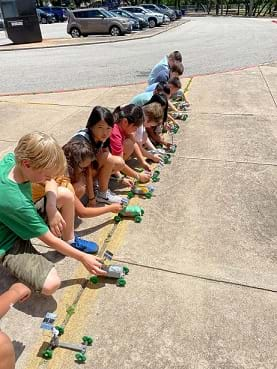
- Discuss the adjustments with each group. Ask students: Why do you think this change would improve the speed of your car?
- Go back outside to have students retest the adjusted designs and record any changes in the speeds of their cars.
- After retesting, discuss as a class:
- What did you notice after the changes were made?
- Did the changes improve the distance your car traveled? Why or why not?
Post Activity:
- Encourage students to think about the future of car designs. Ask students: What part of this lesson do you think might be important three years from now? Why?
- Have students complete the Exit Ticket.
Vocabulary/Definitions
light energy: An energy beam that moves in wavelengths.
nonrenewable resource: Natural resources that cannot easily be replaced.
renewable resource: Made from resources that nature will replace.
Assessment
Pre-Activity Assessment
Introduction and Motivation: Read aloud Rosie Revere, Engineer. Have students watch videos about renewable resources and light energy: What is Solar Energy? (5:07 minutes) and What is Light Energy? (3:40 minutes). Have students brainstorm what makes a good power source together with a partner. As students share out, record ideas on a whiteboard.
Activity Embedded (Formative) Assessment
Working through the EDP: Students follow the EDP to plan and build a car out of recycled materials, including a solar panel kit. As they test their cars, ensure that students are recording their observations on the Data Collection Worksheet.
Post-Activity (Summative) Assessment
Review, Rebuild, and Retest: After students have tested their cars, ask them to reflect on the experience: What did you notice? Are there any changes you want to make? Students will record their reasons on the Data Collection Worksheet, make the changes, and take the car back outside and retest and record results.
Exit Ticket: At the end of the activity, students will complete an Exit Ticket naming three things they learned, two skills they used, and one idea they’d like to explore further.
Troubleshooting Tips
- To keep costs down, you could very easily do this as a whole class or make the teams larger. There are also many other kits like this now available that cost less.
- Make sure the recycled materials offered are easy for students to cut or bend. You don’t want to find yourself in a situation having to use a knife.
- Be prepared for cloudy or rainy days; the experiment cannot be successful unless it is sunny.
Activity Scaling
This activity could be used with 4th and 5th graders as well. Because the rovers are reusable, you could do this over and over with different grades/classes.
For older students:
- You could extend into reflection and refraction and how that affects the solar panel.
- Mass could be considered as a variable to performance as well.
Subscribe
Get the inside scoop on all things TeachEngineering such as new site features, curriculum updates, video releases, and more by signing up for our newsletter!More Curriculum Like This

Students learn and discuss the advantages and disadvantages of renewable and non-renewable energy sources. They also learn about our nation's electric power grid and what it means for a residential home to be "off the grid."
References
Beaty, Andera. Rosie Revere, Engineer. New York, New York: Abrams Books for Young Readers, 2013.
Wood, Sarah. The Engineering Design Process. June 8, 2020. My Tech World. SciToons. What is Solar Energy. May 13, 2017. Brown University. Turtle Diary (Brain Star). What is Light Energy. May 11, 2016.
Design Based Learning Workshop. Lacy Bartlett, Joe Lee Johnson STEAM Academy, Round Rock ISD. PLTW Coordinator. June 16, 2022.
Copyright
© 2024 by Regents of the University of Colorado; original © 2022 University of Texas at AustinContributors
Catherine Jones, Brenda Weathers, Dr. Edward Yu, Claire GanskiSupporting Program
Research Experience for Teachers (RET), The Material Science and Engineering Department, University of Texas at AustinAcknowledgements
This curriculum was developed under National Science Foundation RET grant no. DMR-1720595— Center for Dynamics and Control of Materials at the University of Texas at Austin. Any opinions, findings, and conclusions or recommendations expressed in this material are those of the authors and do not necessarily reflect the views of the National Science Foundation.
Last modified: March 7, 2024







User Comments & Tips